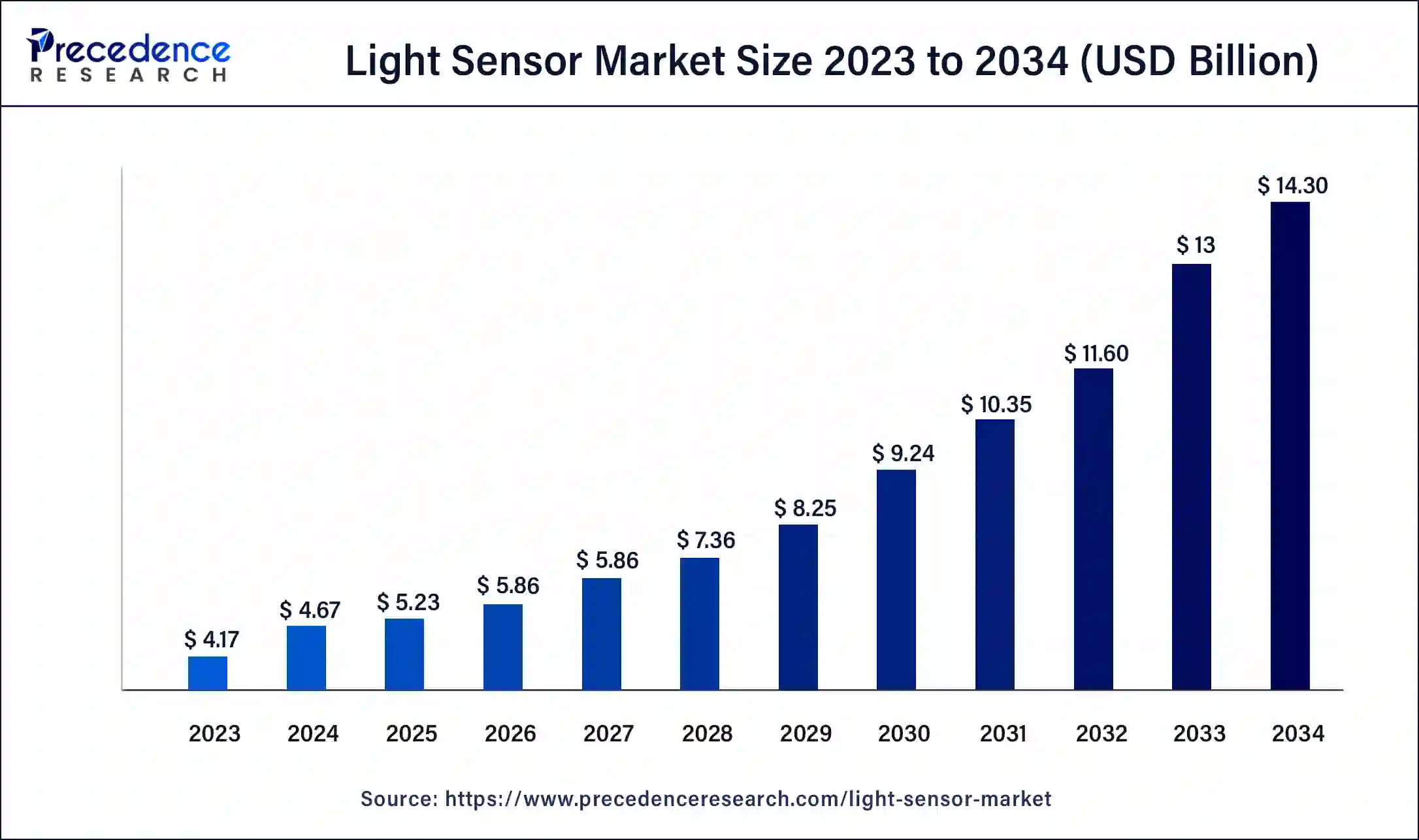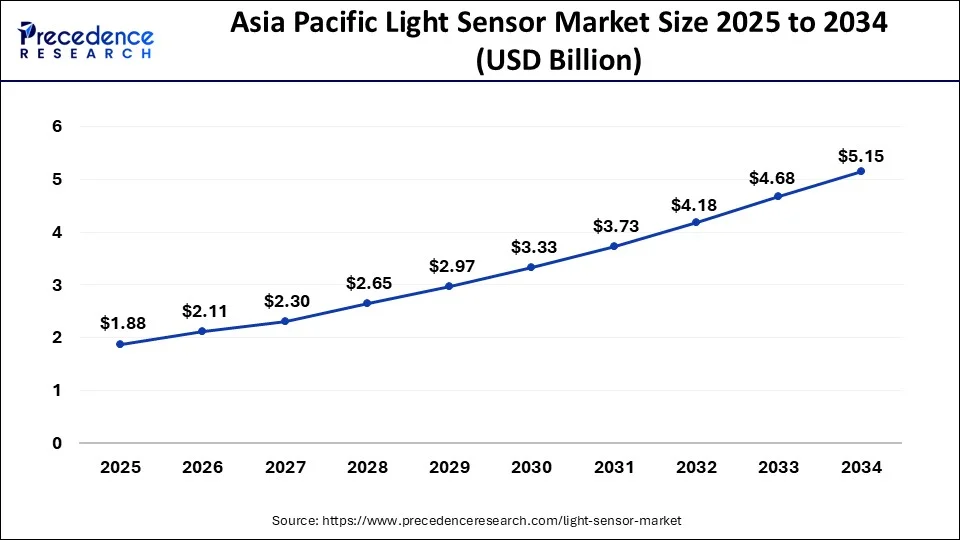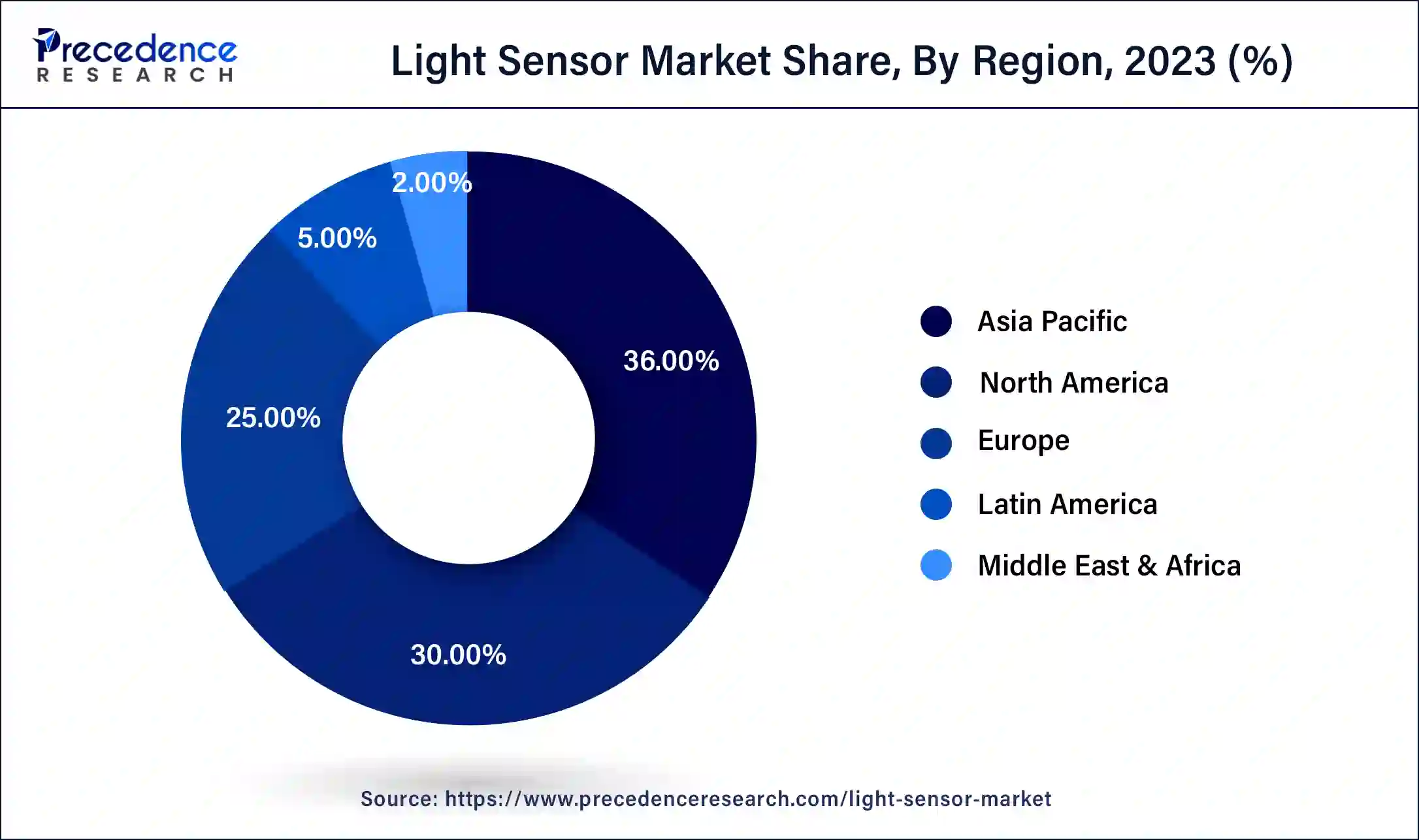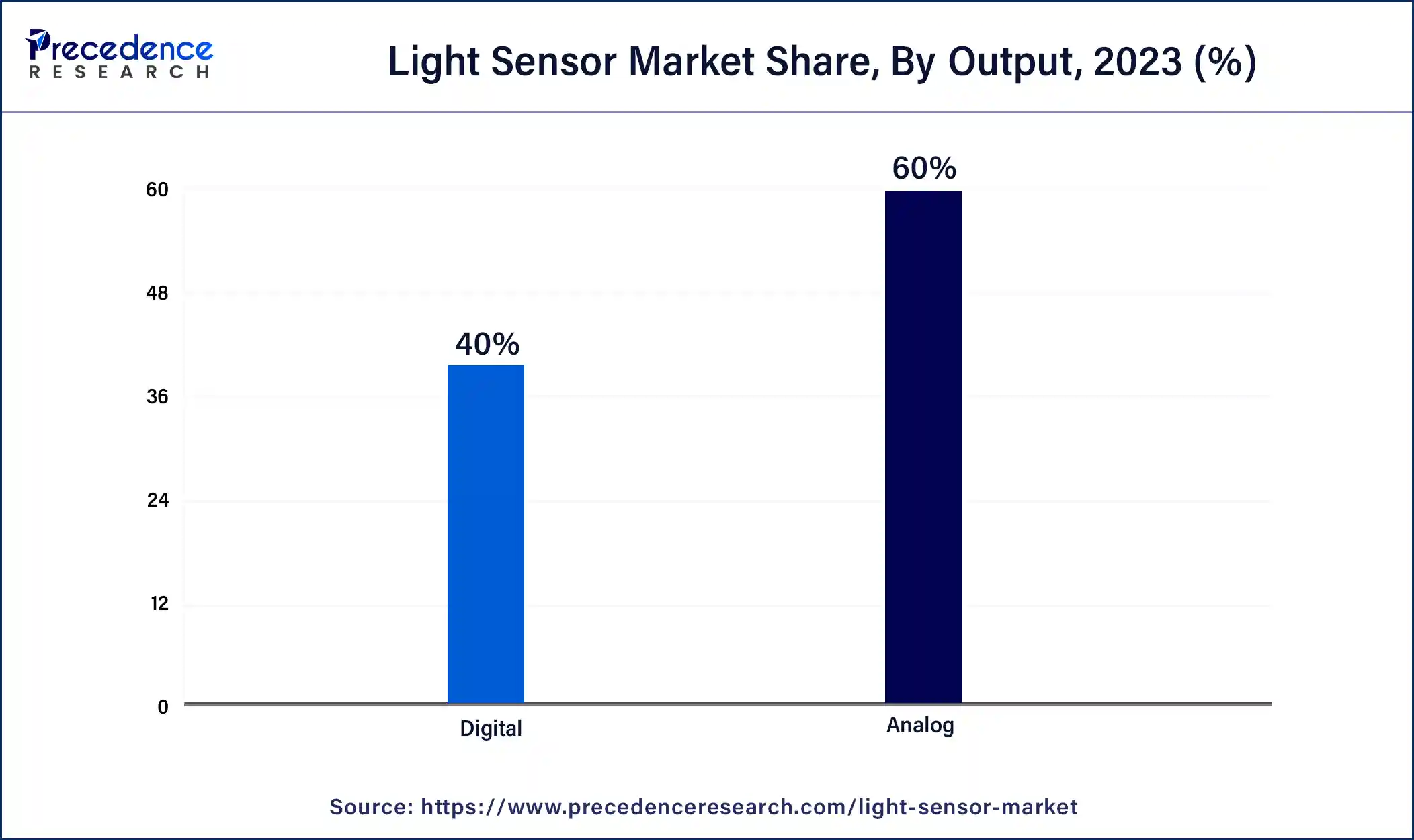List of Contents
Light Sensor Market Size and Forecast 2025 to 2034
The global light sensor market size was calculated at USD 4.67 billion in 2024 and is expected to reach around USD 14.30 billion by 2034, expanding at a CAGR of 11.84% from 2025 to 2034. Major factors driving the demand for light sensors are the rise in the use of consumer electronics, the miniaturization of sensors, and the growing demand for implementing renewable energy.

Light Sensor Market Key Takeaways
- In terms of revenue, the light sensor market is valued at USD 5.23 billion in 2025.
- It is projected to reach USD 14.30 billion by 2034.
- The light sensor market is expected to grow at a CAGR of 11.84% from 2025 to 2034.
- Asia Pacific has generated more than 36% of market share in 2024.
- North America is expected to expand at the notable CAGR of 12.15% in the coming years.
- By output, the digital segment has contributed more than 60% in 2024.
- By output, the analog segment is expected to grow at a significant CAGR of 10.34% during the projected period.
- By function, the ambient light sensing segment has recorded over 30% of market share in 2024.
- By function, the proximity detection segment is projected to grow at the fastest CAGR of 13.08% between 2025 and 2034.
- By application, the consumer electronics segment has accounted more than 36% of market share in 2024.
- By application, the healthcare segment is anticipated to witness the remarkable CAGR of 13.26% during the forecast period.
Asia PacificLight Sensor Market Size and Growth 2025 to 2034
The Asia Pacific light sensor market size surpassed USD 1.68 billion in 2024 and is predicted to be worth around USD 5.15 billion by 2034 at a CAGR of 11.85% from 2025 to 2034.

Asia Pacific dominated the light sensor market share of 36% in 2024, mainly due to its large population and rising demand for smartphones and consumer electronics. Also, the increasing availability of handheld devices with built-in light sensors is set to boost market growth. Governments in developing countries like India and China have imposed strict safety regulations, prompting automobile makers to include more sensors in mid-range vehicles. These developments are anticipated to fuel the demand for light sensors in the Asia Pacific in the coming years.

North America is expected to experience significant growth in the coming years because it has been quick to adopt light detection solutions. Many companies, like Analog Devices, Inc., Broadcom, Inc., and Maxim Integrated Products, Inc., are actively involved in innovating and developing sensors in this region. Although the United States leads globally in sensor design and research, most manufacturing occurs in the Asia Pacific region. This pattern is likely to persist in the future. Some uncertainties in global politics, particularly regarding trade policies, have prompted the U.S. industry to devise new strategies to remain competitive.
Market Overview
Light sensors detect radiant energy across a range of frequencies, from infrared to ultraviolet light, and convert it into electrical signals. They have diverse applications, such as helping farmers hydrate crops by connecting them to sprinkler systems and optimizing watering schedules with weather-monitoring equipment. Light sensors are also used in freight shipping to track cargo by detecting changes in light exposure when containers are opened.
The light sensor market has found applications in smartphones, computers, TV remotes, automobiles, and streetlamps to adjust brightness and activate lights automatically. Furthermore, these sensors can measure virus concentration in the air using localized surface plasmon resonance (LSPR) technology. With ongoing technological advancements, product developments, increasing industrial automation, and collaborations in the industry, the market is expected to continue growing.
Light Sensor Market Growth Factors
- Advancements in outdoor lighting, smart homes, and the automotive sector are anticipated to boost the growth of the light sensor market.
- To improve the driving experience, car manufacturers are focusing more on interior aesthetics, which can contribute to the market.
- Enhancement and miniaturization in sensor technologies have resulted in a rise in demand for smart electronics.
- Continuous developments in the relatability and quality of lighting detection have led to growing competition among the market players.
- Technology such as nanoscale photonics is also experiencing high demand in smart city infrastructure, which can further fuel the light sensor market's growth.
Key Growth Trends
- Increased Use in Consumer Electronics: Light sensors are already present in smartphones, tablets, and laptops for adaptive brightness and performance with regard to integrated cameras and, increasingly, wireless communication. Demand is only going to grow with each new observation of light sensor technology, with every upgrade of a device.
- Growth in Directives for Smart Lighting and IoT Devices: Use of light sensors is also increasing in smart lighting designs and IoT-based automation solutions, especially in the world of smart homes and smart city infrastructure.
- Increased Applications in Automotive Systems: Advanced driver assistance systems (ADAS), automatic headlights, and ambient lighting systems are all recent applications of light sensors in modern vehicles and are supporting the growing automotive market in these segments.
- Looking Towards Energy Efficiency and Environmental Monitoring: Light sensors directly influence energy usage in lighting systems and are also used by agriculture and environmental concerns to monitor light conditions and contribute to sustainability efforts.
Market Scope
| Report Coverage | Details |
| Global Market Size by 2034 | USD 5.15 Billion |
| Global Market Size in 2025 | USD 5.23 Billion |
| Global Market Size in 2024 | USD 1.68 Billion |
| Growth Rate from 2025 to 2034 | CAGR of 11.84% |
| Largest Market | Asia Pacific |
| Base Year | 2024 |
| Forecast Period | 2025 to 2034 |
| Segments Covered | Function, Output, Application, and Region |
| Regions Covered | North America, Europe, Asia-Pacific, Latin America, and Middle East & Africa |
Market Dynamics
Driver
Innovation in AI and ML
Light sensors have become a trend in smart city applications and emerging tech innovations, which are supported by artificial intelligence and machine learning technologies. The market is growing due to prospects across different industry verticals due to growth in automation. Moreover, the surge in the telecommunication industry and advancement in IoT devices have led to market growth. The other innovative technologies, like nanoscale photonics, are experiencing high demand from market players for their utilization in smart city infrastructure. Fueling the growth of the light sensor market.
- An article published on October 2023 by a 24-7 press release underscores the use of photonic crystals. Photonic crystal structures have excellent light control properties and are hot topics in photonics. New femtosecond laser processing technologies are urgently needed to prepare photonic crystal structures with nanoscale three-dimensional spatial resolution inside the crystal.
Restraint
Bezel-less designs
Smartphone manufacturers like Apple and Samsung are increasingly creating phones with bezel-less designs. This means the screens cover most of the front of the phone, giving more display space while keeping the phone compact and easy to hold. However, traditional features like the ambient light sensor, which adjusts screen brightness based on surrounding light, are being phased out in many smartphones with bezel-less designs. As a result, the demand for light sensors is decreasing due to the rising popularity of edge-to-edge screens.
Opportunities
Advancements in automotive technology
The light sensor market is being driven by several factors, including their use in consumer electronics like smartphones and tablets. Advancements in automotive tech, smart homes, and outdoor lighting are also boosting demand. The rise of smart cities and IoT technology is further fueling this growth. Proximity light sensors play a key role in detecting motion or nearby objects by sensing changes in infrared light. They're often used in vehicle devices to alert drivers about obstacles and in outdoor lights for security purposes. Moreover, Smartphone makers are actively integrating new technologies to enhance product quality and user experience.
Rise in smart city infrastructure
The rise of smart cities is a big trend in the light sensor market. In these cities, lights will use sensors to be energy efficient. For example, they'll automatically adjust brightness based on natural light, saving electricity. As more smart cities are built, the demand for light sensors will go up. Furthermore, there's also a growing demand for light sensors in consumer electronics. This is because of things like smaller sensors, more gadgets, and the push for renewable energy. Plus, improvements in cars, smart homes, and outdoor lighting are also boosting the market. New tech, like better manufacturing and faster circuits, are making sensors more reliable and efficient, improving the quality of products that use them.
Output Insights
The digital segment dominated the light sensor market in 2024. In applications such as lighting control, air conditioning, temperature control systems, and ventilation, these parameters must be adjusted based on the intensity of ambient light. With the rise in the use of screen-based devices such as cell phones, laptops, and television sets, these segments are likely to experience substantial market growth during the forecast period.

The analog segment is expected to grow at a significant rate during the projected period. Analog light sensors are generally used in sectors such as healthcare, industrial automation, consumer electronics, etc. The versatility of analog light sensors is important for achieving appropriate measurement of light in diverse environments.
Function Insight
The ambient light sensing segment was the top revenue generator in the light sensor market in 2024. Light sensors have become crucial in meeting design requirements for consumer electronics. Technology is increasingly used in smart electronics, adjusting LCD and LED screen brightness based on ambient light levels. This not only saves energy but also provides users with optimal screen brightness for their environment.
In the light sensor market, the proximity detection segment is projected to experience the fastest growth. This growth is fueled by its extensive use in automotive and industrial manufacturing. Proximity detectors detect changes in infrared light to sense motion or nearby objects. They're frequently utilized in vehicles to warn drivers about nearby objects and in outdoor lights for security and detecting movement.
- In March 2024, with the new W10 photoelectric proximity sensor, SICK presents a sensor that can be used to solve a wide range of detection tasks in automation technology more universally than ever before.
Application Insight
The consumer electronics segment dominated the light sensor market in 2024. This is attributed to the rise in demand and use of different electronic products among consumers. Light-sensing devices are experiencing a rise in demand from laptops, LCD/LED televisions, and smartphones. The sensors also automatically maintain the screen's brightness by responding to the light present in the environment.
The healthcare segment is anticipated to witness the fastest growth during the forecast period in the light sensor market. Light sensors are also used in the medical field to detect pathogens, diagnose blood, and monitor patient oxygen levels. These advancements will contribute to the market expansion in the coming years.
- In June 2023, Kyoto Semiconductor Co., Ltd., a leader in optical device solutions with Japanese quality manufacturing based on world-class technology, announced 14 products of SWIR*1 type reflective sensor “KPR series." This type of sensor was developed with the expectation of being used in various applications, such as the healthcare and medical fields.
Light Sensor Market Companies
- ams-OSRAM AG
- Analog Devices, Inc.
- Broadcom
- ELAN Microelectronics Corp.
- Everlight Electronics Co., Ltd.
- Rohm Co. Ltd.
- Samsung
- Sharp Corporation
- Sitronix Technology Corporation
- STMicroelectronics
- Vishay Intertechnology, Inc.
Recent Developments
- In January 2025, Sony Electronics announced the AS-DT1, a compact and lightweight LiDAR depth sensor designed for precise 3D measurement. The AS-DT1 uses Sony's proprietary Direct Time of Flight (dToF) LiDAR technology. This system measures distance by calculating how long it takes for light to reflect off a surface. (Source: dronelife.com )
- In May 2025, Vishay Intertechnology, Inc. introduced the VEML4031X00, an AEC-Q100 qualified ambient light sensor designed for automotive applications. The sensor integrates an ambient light sensing (ALS) photodiode and an infrared (IR) photodiode within a compact surface-mount package measuring 4.38 mm × 1.45 mm × 0.6 mm. It includes a dedicated IR channel, which helps distinguish ambient light sources based on their spectral content. (Source: globenewswire.com )
- In March 2025, EarthTronics introduced EarthConnect area light sensors with extended outdoor range for commercial lighting applications. These features provide the ability to control exterior lighting from a smartphone or device with multiple energy-saving functions that help to increase the effectiveness of a security lighting system. (Source: livedesignonline.com )
- In May 2024, Lumotive, a pioneer in optical semiconductor technology, and Hokuyo Automatic Co., Ltd., a global leader in sensors and automation, announced the commercial release of the YLM-10LX 3D lidar sensor. This groundbreaking product, powered by Lumotive's Light Control Metasurface (LCM™) optical beamforming technology, represents a major leap forward in applying solid-state, programmable optics to transform 3D sensing across industrial automation and service robotics applications. (Source: prnewswire.com )
- In May 2023, DANLERS, an energy-saving lighting company, CALUMINO, a hardware and AI startup, and INGY joined forces to create an innovative, intelligent lighting control sensor. The groundbreaking DANLER's CAL-CEFL12V incorporates CALUMINO's advanced thermal sensor technology, embedded AI, and computer vision.
- In November 2022, ams-OSRAM AG introduced a three-channel UV-A/B/C Sensor AS7331. The AS7331 measures radiations at UV-C, UV-B, and UV-A wavelengths. It has applications in coffee brewing machines, robotic floor cleaners, and water and air purifiers. In addition, it has applications in healthcare for UV curing and Phototherapy.
- In July 2022, Vishay Intertechnology, Inc.'s Optoelectronics group unveiled a reflective optical sensor suitable for automotive, smart home, industrial, and office purposes. This AEC-Q101-qualified sensor boasts a compact design with the emitting light source and detector positioned in the same plane.
- In May 2022, AMS AG, a leading sensor manufacturer, announced the launch of a new high-precision ambient light sensor with improved sensitivity and dynamic range. This sensor targets applications like automatic brightness control in smartphones and wearables.
- In January 2022, Panasonic launched a flagship OLED TV, the LZ2000. The TV is available in 55-inch, 65-inch, and 77-inch sizes. It features a new ambient light sensor that adjusts the picture quality based on the time of day.
Segments Covered in the Report
By Function
- Ambient Light Sensing
- Proximity Detection
- RGB Color Sensing
- Gesture Recognition
- IR Detection
By Output
- Analog
- Digital
By Application
- Automotive
- Consumer Electronics
- Industrial
- Healthcare
- Others
By Geography
- North America
- Europe
- Asia-Pacific
- Latin America
- Middle East and Africa
For inquiries regarding discounts, bulk purchases, or customization requests, please contact us at sales@precedenceresearch.com
Frequently Asked Questions
Ask For Sample
No cookie-cutter, only authentic analysis – take the 1st step to become a Precedence Research client